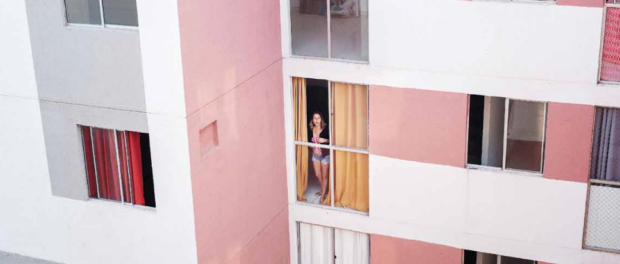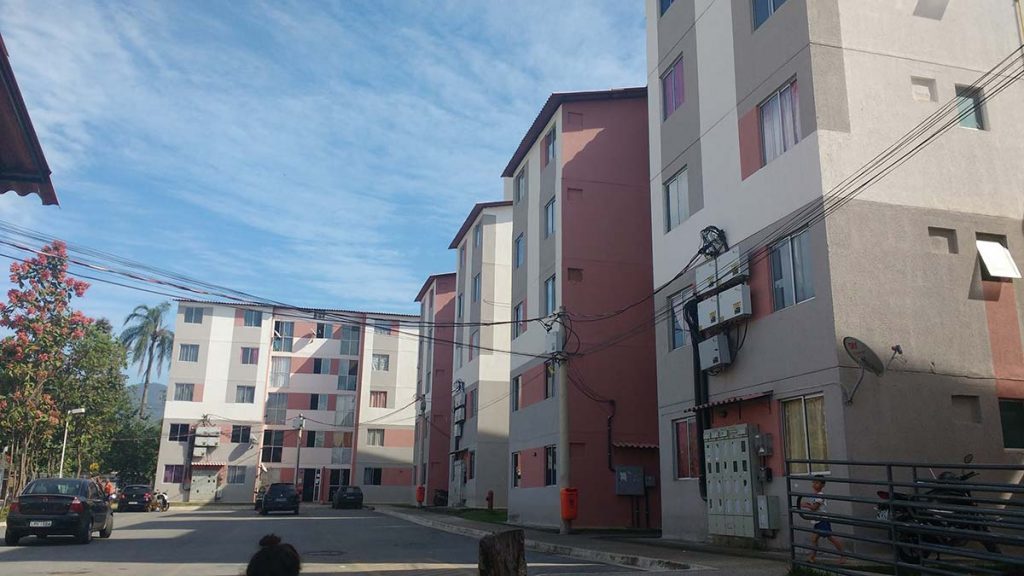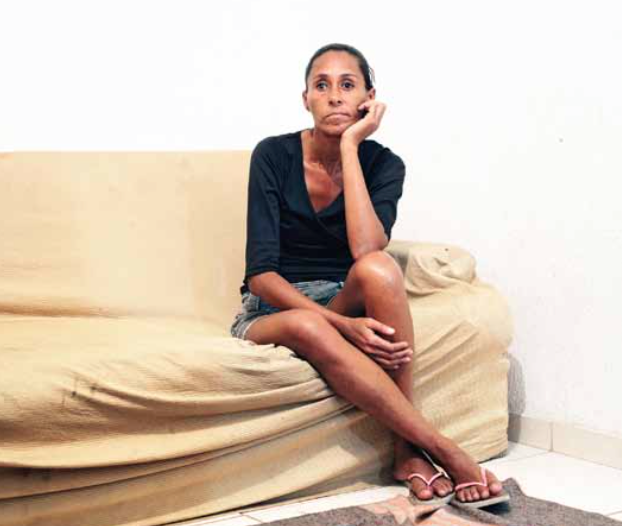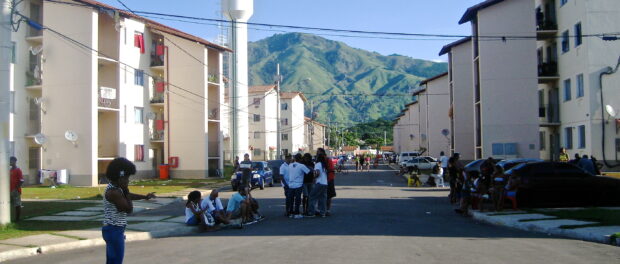
For the original article by Adéle Smith in French published by Le Monde click here.
It was too good to be true. When Isabella Ribeiro received the keys to an elegant two-room apartment in April 2015, she burst into tears “of joy,” says Ribeiro, who has lived her whole life–56 years–in a favela. The federal government had just made her the happy owner of a 45 square-meter apartment in a brand new five-story building.
In the Colônia Juliano Moreira housing complex, built on territory previously owned by slave owners, the roads were paved, there was running water, large orange garbage bins outside, and proper sewerage. “It was beautiful,” she remembers. She could not imagine the turn of events that would follow. A year and a half later, she finds herself threatened with eviction for unpaid credit. “I receive threatening letters, endless phone calls, someone from the bank called me a slut on the phone!” she says, discouraged. Boxes filled with medication for blood pressure are scattered in her small living room, where a small statue of Christ stands.
2.6 million home beneficiaries
Isabella is one of some 2.6 million households selected according to financial and health criteria to benefit from Minha Casa Minha Vida, the social housing program launched in 2009 by ex-president Lula for, as he said at the time, “getting people out of this s***.” By escaping [precarious] favelas in which they were confined for generations, these poorly housed people were supposed to naturally escape misery. Large anti-poverty programs, led by Luiz Inácio Lula da Silva, gave the wildest hopes to citizens of this country, where inequality thrives. The Bolsa Família cash transfer program, notably, is the social program most reproduced in the world.
Although neither innovative nor original, Minha Casa Minha Vida has in seven years become the most ambitious social housing program in Brazil since the end of the dictatorship, with 4.5 million small houses and apartments delivered or under construction. It has had a certain impact on the housing deficit, but the impact on poverty is questionable. The future of the program is uncertain. With the end of the Brazilian economic miracle and the immense disappointment around President Dilma Rousseff, criticism has crystallized around left-wing social policies, deemed too costly. Michel Temer’s government intends to reform Minha Casa Minha Vida.
In Rio, the program has an additional particularity in the Olympics. The Rio city government has used the program, with remarkable opacity, to relocate residents of [in many cases functional] favelas that were destroyed for the Olympic Games. The mayor, Eduardo Paes, promised free compensation housing, leaving the responsibility of repaying the property loan to the municipality instead of the owners. But in Colônia, residents continued to receive debt notices from creditors and are now being labeled as “bad payers.”
Long waiting lists
Yet the program, better known by its acronym MCMV, is generous. It is subsidized up to 95% by the State for almost half of its beneficiaries, those with very low incomes like Isabella (less than R$1,800 per month, approximately US$550). It is also very popular. The waiting lists are long. But it relies on a Public-Private Partnership between the federal government and the real estate sector, facilitated by local authorities. In other words, the public works enterprises choose low market value land on the cities’ periphery and aim to make them profitable. This does not necessarily produce human well-being.
In Colônia, today, there are tears in the office of the condominium representative, part security guard, part Mother Teresa, Julia de Oliveira. Reminders from creditors are far from being the only problem. As in other MCMV projects, the word “bill” provokes general anxiety. With their off-the-grid, wild development, favelas had a good side: people were not ruined financially. Here, of course, one must pay for everything: gas, television, Internet, but also electricity and condominium fees.
Yet by moving to this suburb, isolated and far from the city’s center, many have lost their jobs. Francisca Bezerra, a housewife, would never go back to her favela, but she had to give up the Internet and is now finding herself barred from accessing credit. A recent sociology study from London School of Economics shows increasing financial difficulties in more and more of these projects.
Isabella Ribeiro was a seamstress in the favela. She rented a studio near Colônia, but ended up giving it up, incapable of facing the financial stress it caused. Her sewing machine and thread spools are now accumulating dust in a corner. These projects are built solely for housing, not for commercial or service purposes. As the saying goes, however, necessity is the mother of invention; we can thus spot here and there signs at windows offering small services such as hairdressing and manicures, just like in the favela.
Isolated by an expressway, Colônia was built in the West Zone of Rio, deprived of access to metro lines. It is far from the city’s Northeast zone and the center, where the majority of employment is concentrated. The number of traditional buses has been reduced and the new ones, although faster, are much less frequent. “We are also still waiting on the clinic that was promised to us. The closest one is an hour away by car,” adds Ariana, mother of a 5-year-old boy. To make things worse, water and electricity cuts are recurrent. In the middle of a conversation, caretaker Julia de Oliveira stops to block the road from an agent of the local water company, who came to cut the supply without previous notice.
“It’s a constant battle,” she explains after having persuaded the man to give up on his task. The residents refuse to pay the bills for water they had been promised would be provided for free. Julia de Oliveira blames the degradation of municipal services on the economic crisis. On the other hand, other residents suspect city government’s disdain for the “poor.” The neighboring housing project Parque Carioca, presented as a “model,” is already in a mediocre state. The swimming pool, intended for residents, has been abandoned.
“The MCMV program unfortunately reproduces schemas of segregation and social injustice,” says Meg Healy, researcher and collaborator with the non-governmental organization Catalytic Communities. Is Colônia at risk of ghettoization in the long term? “Not at all, people have found their dignity here,” reassures Julia de Oliveira, optimistic. With no husband or children but with two different jobs, she gets through her days fine, but recognizes that the joint effect of the economic crisis and isolation is a factor of insecurity. “It is more difficult for those who can’t or don’t want to work,” she says.
A plan aiming to sustain the real estate sector
Ex-special rapporteur on adequate housing for the UN, Raquel Rolnik, fears the program will create “future ghettoes of poverty.” Author of a recent book Guerra dos Lugares (“War of Places”), she deems that it is “primarily a success for the public works and finance sectors.” One must only remember the genesis of this plan launched in the middle of the electoral campaign, she says: presented as a policy of social housing, it had more of an objective to support the real estate construction sector and face the global financial crisis of 2008.
“It is in no case a program for social housing,” she repeats, the interests of real estate speculators being “incompatible” with that of residents. Today, the public works sector is pressuring the government to maintain it. “It would not be wise to reduce or interrupt a program of such a large scope,” confirms the president of the Association of Real Estate Company Directors (Ademi), João Paulo. R$300 billion (US$92 billion) have been invested since 2009.
Of a modest size and less isolated than others, Colônia is a “light” version of these giant complexes built in Brazil, but it is the same construction model that is found pretty much everywhere. On an afternoon like today, Patricia Fernandes can be found at the bottom of her building, killing time in the company of her neighbors. With no benches around, they sit on the ground. The complex’s architect has apparently opted for a minimalist design.
A touch of yellow and pink here and there brightens up the complex. But Colônia could use some more trees, in this country where everything grows so easily. On the horizon, the green hills remind us that it’s nature, not architecture, which makes Rio one of the most beautiful cities in the world. When boredom becomes too much in the complex, residents end up on the sofa watching telenovelas–Patricia and her daughter love “My Heart Belongs to You.” There is no hot water in the kitchen, no mirror in the bathroom, no lightbulb on the ceiling, but the plasma screen is sacred in Brazil.
The young woman owns an apartment identical to that of Isabella Ribeiro but the Fernandes family is crammed. Six in this two-room apartment: her, her husband, their children of 11 and 18 years old, and her sister, who shares a single bed with her 5-year old son. Patricia is not a connoisseur of architecture, but she wonders why all the apartments are built with a large opening in the kitchen wall without a window to complement it. The picture is the same in other complexes. When it rains, the water has to be mopped up. Tropical rains in Brazil can transform your kitchen into a swimming pool if you don’t take care of it.
Unlike other residents, she doesn’t have the problem of sinking floors, or cracks in the walls. The quality of MCMV construction is constantly the object of criticism. In 2013, a brand new housing project had to be demolished before new arrivals moved in. Walking through Colônia, one can’t help but wonder: how many years before this place becomes decrepit?
Strict rules, a heavy atmosphere
During conversations with residents, one subject comes up often. A new, clean apartment instead of a squalid shack is a wonderful idea on paper. But, in reality, these new projects cause a profound change in the urban fabric and lifestyles. Hygiene and good lighting are well appreciated; austerity and heaviness less so.
There’s no music or outdoor barbecues that were the charm of communal life in the favelas. A large fence surrounds Colônia, and each building is accessible solely via interphone. Only those invited can enter here. The rules are strict, sometimes arbitrary.
Some don’t adapt well. Patricia was forced to abandon her dog, Jack. “I would rather go back to the favela. The family house was larger and more comfortable. We felt more free,” she explains. Some have already rented their apartment to go back to the favela or earn some extra money. Others are talking of selling, even though this is prohibited for ten years: an aspect of social housing that is itself not very “social.”
The second half of the program is reserved for middle class people with incomes from US$540 to US$1,900 per month, those which the Temer government intends to prioritize. They have a wide choice of geographic placement and apartments of slightly higher quality, but they are less affected by housing shortages and are anyway confined to large monolithic parcels. At least the MCMV program has opened up access to credit on the real estate market for them, a real progress in Brazil, concedes Raquel Rolnik.
Many consider that, for a program so vital to urban development in Brazil, MCMV suffers from a serious democratic deficit. Daniel Fereira, a jovial man in his sixties, has always lived in a favela. He spent 20 years building his own house of 57 square-meters and watched his children grow up in it. The government offered him a 45 square-meter apartment–a 12 square-meters downsize. He refused. “Because we are poor, people want us to accept anything and everything while the City and construction workers speculate behind your back. That’s not democracy,” he says.
The president of the Brazilian Institute of Architects (IAB), Sérgio Margalhâes, shares this opinion. The city, he defends, must be built in an inclusive manner. However, neither urban planners nor architects, nor those mainly concerned are really associated with this program, which is rather led by force by real estate contractors and the government. “80% of housing in Brazil has been built by people who are often very poor, without any help. Favelas are the direct result of that. To offer them the MCMV model is disrespectful,” affirms Magalhães, who advocates favela upgrading.
It’s actually a disaster for the future of cities, he claims. “Horizontal expansion of cities to the detriment of density, without the infrastructure or services that come with it, is a social, urban and environmental ticking bomb,” he concludes in his Rio office. Governments sometimes have a short memory.
The social housing policy of the 1960s in Brazil, of which MCMV is considered the near-perfect copy, gave birth, over two generations, to segregated communities of exclusion and violence like City of God, immortalized in Fernando Meirelles’ movie. Colônia was built close to this immense favela. Drug traffickers wander around the new housing projects and militia extort residents, who are afraid of speaking. In Colônia, violence is already part of daily life.
Lucas Mezes, a 20-year-old carpenter, would have never imagined that access to property could have such a significant human cost for his family. He and his two brothers, Thiago, 18, and Mattheus, 21, have all become owners of identical apartments. Two in Colônia, and one in Parque Carioca, some kilometers away.
In the past, the Mezes family lived in a favela that was known to be quite calm, Vila Autódromo, now a symbol of resistance against the Olympics. “It was a small paradise,” remembers Lucas, whose face has been disfigured from eye to chin following a motorcycle accident. When their house was destroyed, their father, a fisherman on the lagoon, never recovered, recounts the young man. The family of five was separated geographically, all arbitrarily. For the trio of boys, who are very close, this was challenging.
Last month, the eldest son, Mattheus, was killed in Colônia by four bullets to the back following a misunderstanding. Lucas is now responsible for his family. Quite a burden for a 20-year old. “My dream today is that my life doesn’t go down the deep end.” But Lucas has kept the joie de vivre typical of Brazilians: he is convinced that his family has a future in the housing project.




